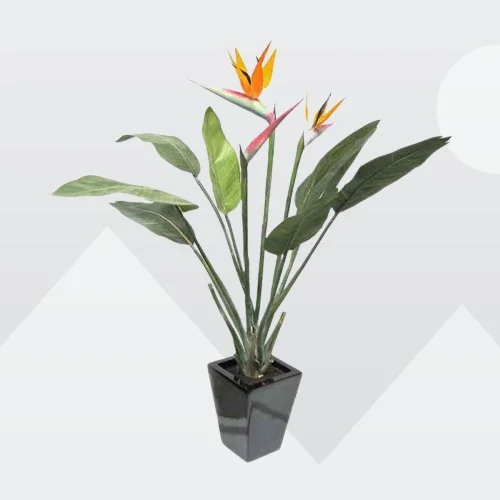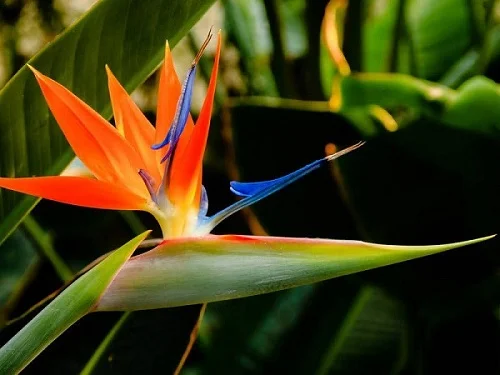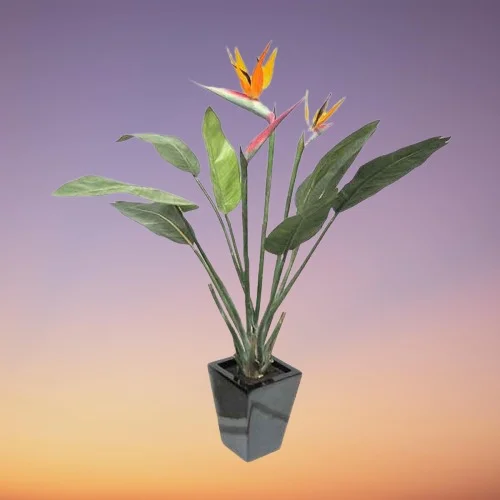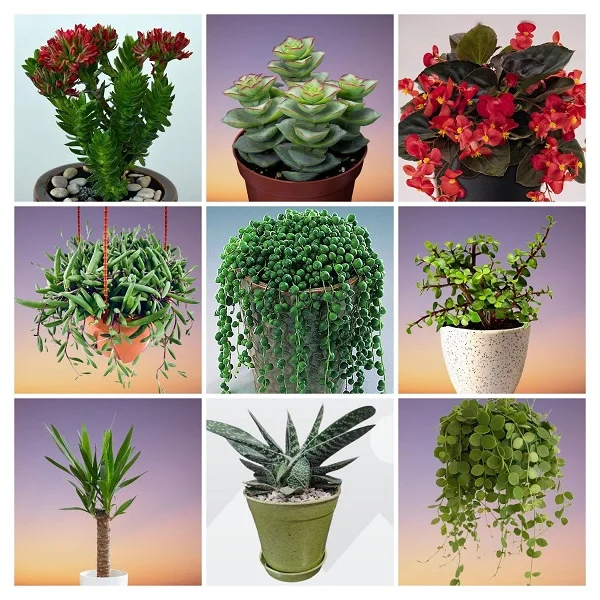Bird of Paradise Plant (Strelitzia reginae) Indoor Care, Propagation, Problems with Remedies
Some links in this post may be affiliate links
Bird of Paradise Plant (Strelitzia reginae) blossoms in bright light with some direct sunshine, average warmth, humid conditions and consistently moist, rich, well-drained, all purpose soil coupled with monthly feeding in the growing season.
Strelitzia reginae also called Crane Flower is one of the popular flowering plants and bears vivid bright orange and blue flowers on top of tall stalks and are surrounded by large leaves which can last for several weeks.
Crane Flower is frost-tender below 100C and is suited for the warmer climates. In the US, the plant is a common landscape feature in California and Florida. It is so popular that it has been choosen as the official flower of the city of Los Angeles.
In colder climates, Bird of Paradise can be grown as an indoor plant or in containers which can be taken inside during the harsh winter weather where they can be sheltered from frost, as it can damage the flowers and leaves. It is ideal for USDA zones 10-12.
The species was described by Joseph Banks in 1788. The species name, 'reginae', means 'of the queen', in commemoration of the British queen Charlotte of Mecklenburg-Strelitz, wife of George III.

Botanical name: Strelitzia reginae
Family: Strelitziaceae
Common names: Bird of Paradise Plant, Crane Flower
Origin
Strelitzia reginae is an evergreen perennial plant indigenous to South Africa.
Size
Bird of Paradise Plant grows to a height of about 5-7 feet and 3-4 feet wide. The evergreen leaves are arranged in two ranks, making a fan-shaped crown. They are upto 28 inches long by about 12 inches wide and are borne on 40 inches long stalks making it one of the best large-leafed plants for a bold statement in any space.
Flower
The flowers in Bird of Paradise Plant fan out from the spathe, forming a crane bird-like crest. The plant may take up to 4-6 years before flowering starts but each spathe will produce several flowers in succession. The common names, 'Crane Flower' and 'Bird of Paradise' refer to the open flower's resemblance to the head and beak of a colorful exotic bird.
Related Plants
Popular plants related to Strelitzia reginae include Strelitzia nicolai (White Bird of Paradise Plant) which bears large, paddle-shaped, grey-green leaves arranged in a fan-like shape and Ravenala madagascariensis (Traveller's Palm) with paddle-shaped leaves on long petioles, arranged in a fan-shape in a single plane.
Toxicity
Bird of Paradise Plant is non-toxic to humans but toxic to pets as indicated by ASPCA. If ingested it can cause difficulties in breathing and abdominal pains. Keep the plant out of the reach of pets.
Where to Buy
If you would like to add Bird of Paradise Plants to your collection, you may easily acquire them online from Amazon (Link to Amazon) or from Etsy (Link to Etsy).
Strelitzia reginae Care Indoors
Bird of Paradise Plant (Strelitzia reginae) flourishes in bright light with 4-6 hours of direct sunshine, average warmth of 16-270C, humidity of 60-70% and consistently moist, fertile, well-drained, all purpose potting soil coupled with monthly feeding during the growing season.
Young plants require annual repotting but mature plants are repotted only when extremely pot-bound as they bloom best when the roots are confined. Pruning is needed to keep the plant neat and also discourage pest and disease infestations. Keep on reading for more on these growing conditions and how to achieve them.

Watering
Water Bird of Paradise Plant thoroughly during the growing season and keep the soil consistently moist while allowing the top 1-2 inches of soil to dry out between waterings.
Reduce watering during the cold season to maintain the soil slightly moist as growth is minimal at this time but do not allow the soil to dry out completely.
Use water that is at room temperature to water to avoid shocking this tropical plants. The water should also be chlorine-free as the plant is sensitive to chlorine and other chemicals dissolved in water.
Make sure that the pot has a drainage hole to prevent the soil from getting soggy as it can lead to root-rot which is indicated by yellowing and droopy leaves.
Light Requirements
Bird of Paradise Plant grows best under bright light with at least 4-6 hours of sunshine. Do not expose it to hot midday sunlight before acclimatizing it as it can lead to sunburn marks (brown leaf spots).
You may grow Strelitzia reginae under grow lights where the natural light is not adequate. Take a look at these full spectrum grow lights on Amazon.
Rotate the pot regularly to ensure that the plant receives light on all sides for uniform growth and prevent lopsided growth.
Temperature and Humidity
Bird of Paradise Plant thrives in average temperatures of 16-270C. Keep it away from drafts to avoid wilting and crispy leaf edges.
Bird of Paradise Plant requires a humidity of 60-70% to thrive. Low humidity will result in brown, crispy leaf tips and edges. Therefore, set the pot on a wet pebble tray or use a cool mist humidifier to raise humidity.
Occasionally clean the leaves by damp-wiping with a soft cloth to get rid of dust and also reduce pests and diseases infestations. Ascertain that there is proper ventilation to discourage fungal diseases.
Fertilizer
Feed Strelitzia reginae with a phosphorous-rich, water-soluble fertilizer every 4 weeks during the growing season to promote flowering. Do not feed in the cold season as growth is minimal at this time therefore the plant does not need it.
Flush out accumulated salts (which may have arisen from the water or fertilizers) regularly from the soil by running for a few minutes a steady stream of water through the soil until it comes out through the drainage holes. Repeat the process several times.
Potting Mix
The best soil for Bird of Paradise Plant should be rich in organic matter and free-draining to prevent it from getting soggy while providing the required nutrients. All purpose potting mixes are ideal this plant.
Pruning
Pruning Bird of Paradise Plant involves removal of dead blooms and leaves to maintain the plant neat and also discourage pest and disease infestations. Cut the dead leaves at the base with a sharp knife or a pair of scissors.
Repotting
Repot the young Bird of Paradise Plants at the beginning of the growing season in a pot one size larger than the current one.
The mature plants do not require very frequent repotting as the plant prefers to be root-bound to enhance flowering.
Ensure that the pot has a drainage hole and the soil is free-draining soil to prevent it from getting soggy as it can lead to root-rot. Check out these pots with drainage holes on Amazon.
Propagation
Bird of Paradise Plant (Strelitzia reginae) propagation can be done at the beginning of the growing season from seeds or by plant division at repotting time.
How to propagate Bird of Paradise Plant from seeds
Sow the Bird of Paradise Plant seeds about 0.5-1 inches deep in moist free-draining soil.
Cover the set up with clear polythene to create warm and humid conditions which hastens germination and establishment of the plants.
Place the set up in a warm, brightly-lit place and maintain the soil moist thorough out and avoid soggy soil as it can cause rotting.
Germination should occur in about 8 weeks. Allow the Strelitzia reginae to be well established before transplanting after which you can begin routine care.
How to Propagate Plant Bird of Paradise by plant division
During repotting, divide the mother Bird of Paradise Plant into several sections while ensuring each divison has some roots to hasten establishment.
Pot the sections in moist, free-draining soil in individual pots.
Place the set up in a well-lit place and maintain the soil moist until new growth emerges on the sections.
Ensure that the crown of the sections is above the soil level to avoid rotting.
Allow the new Strelitzia reginae to be well established before transplanting after which you can begin routine care.

Strelitzia reginae Problems with Remedies
Bird of Paradise Plant (Strelitzia reginae) growing problems include brown leaf tips, yellow leaves, drooping, leaf spots, lack of blooms, pests and diseases. Keep reading for more on these problems, their remedies and solutions.
Diseases
Bird of Paradise Plant is prone to root-rot which is promoted by soggy soil. Ensure that the pot has a draining hole and that the soil is free-draining to prevent it from getting soggy. Cut down on watering in the cold season to maintain the soil slightly moist as growth is minimal at this time. Read more on how to treat root-rot in houseplants.
Pests
Bird of Paradise Plant is prone spider mites, aphids and fungus gnats infestations. Regularly inspect the plant for pests and take timely control measures for these pests. Isolate the affected plant to prevent spread to other plants and treat it for the pests. Learn how to identify and get rid of pests in houseplants.
Drooping leaves and stems
There are four possible causes of drooping leaves and stems in Bird of Paradise Plant. One possible cause is low humidity. Set the pot on a wet pebble tray or use a cool mist humidifier to raise humidity. You may also grow the plant in a well-lit bathroom, kitchen, laundry area and other humid areas in the home. Check out these techniques on how to increase humidity for houseplants.
The second possible cause of drooping leaves and stems in Bird of Paradise Plant is incorrect watering; either underwatering or overwatering. Maintain the soil moist during the growing season while allowing the top 1-2 inches of soil to dry out between waterings.
Cut down on watering in the cold season to maintain the soil slightly moist as growth is minimal at this time but do not allow the soil ball to dry out completely. Read more on how to water houseplants the correctly.
The third possible cause of drooping leaves and stems in Crane Flower is too high temperature due to exposure to direct sunlight or hot air. Shield the plant from direct sunlight by use of a light curtain to filter the light and keep it away from hot air vents or any heat source.
The fourth possible cause of drooping leaves and stems in Bird of Paradise Plant is pests and diseases. Regularly inspect the plant for pests and diseases and take timely control measures.
Lack of blooms
There are two possible reasons why Bird of Paradise Plant will not bloom (flower). One possible reason is too little light. Move the plant to a brighter spot where it will receive bright light with 4-6 hours of direct sunshine away from hot midday sunlight or instal a grow light if the natural lighting is not adequate. Check out this post on understanding light for houseplants.
The second possible reasons why the Bird of Paradise Plant is not blooming (flowering) is underfeeding. Feed the plant every 4 weeks with a phosphorous-rich, water-soluble fertilizer during the growing season to enhance flowering. Learn how to feed houseplants.
Yellowing leaves
There are two possible causes of yellowing leaves in Bird of Paradise Plant. One possible cause is too wet soil. Ascertain that the pot has a draining hole and the soil is well-drained to prevent the soil from getting soggy.
In addition, reduce watering in the cold season to maintain the soil slightly moist as growth is minimal at this time thus the plant does not require a much water.
The second possible cause of yellowing leaves in Bird of Paradise Plant is cold drafts resulting in sudden drops in temperatures. Keep the plant away from cold drafts and place it away from windy doors and windows to maintain an average warmth of 16-270C. Check out this guide on understanding temperature for houseplants.
Brown leaf tips
There are two possible reasons for brown leaf tips in Bird of Paradise Plant. One reason possible reason is that the air is too dry leading to low humidity. Set the pot on a wet pebble tray or use a cool mist humidifier to increase humidity.
The second possible reason for brown leaf tips in Bird of Paradise Plant is soggy soil. Ascertain that the pot has a draining hole and the soil is free-draining to prevent the soil from getting soggy. Lessen watering in the cold season to maintain the soil slightly moist as growth is minimal at this time.
Brown leaf spots
Brown leaf spots in Bird of Paradise Plant are sunburn marks caused by exposure to direct hot sunlight before acclimatizing the plant. Gradually acclimate the plant before exposing it to the hot direct sunshine outside. Move it to a slightly brighter spot every so often until it can withstand direct sunlight.
You liked it? Share on social media.
Related Content
Amazon Associates Disclosure
Homeplantsguide.com is a participant in the Amazon Services LLC Associates Program, an affiliate advertising program designed to provide a means for sites to earn advertising fees by advertising and linking to amazon.com.





